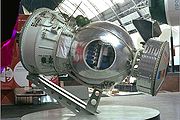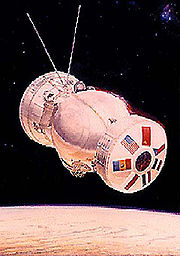
Bion (satellite)
Encyclopedia


Commonwealth of Independent States
The Commonwealth of Independent States is a regional organization whose participating countries are former Soviet Republics, formed during the breakup of the Soviet Union....
) biosatellite
Biosatellite
A biosatellite is a satellite designed to carry life in space. The first satellite with animal was Soviet Sputnik 2 at November 3, 1957. On August 20, 1960 Soviet Sputnik 5 first time recovered animals from orbit to Earth....
s. They were part of the Cosmos satellites
Cosmos (satellite)
Kosmos is a designation given to a large number of satellites operated by the Soviet Union and subsequently Russia. Kosmos 1, the first spacecraft to be given a Kosmos designation, was launched on March 16, 1962....
.
The Soviet biosatellite program began in 1966 with Cosmos 110
Cosmos 110
Kosmos 110 was a Soviet spacecraft launched from the Baikonur Cosmodrome aboard a Soyuz rocket. It incorporated a re-entry body for landing scientific instruments and test objects...
, and resumed in 1973 with Cosmos 605. Cooperation in space ventures between the U.S.S.R. and the U.S. was initiated in 1971, with the signing of the U.S./U.S.S.R. Science and Applications Agreement (which included an agreement on space research cooperation). The U.S.S.R. first offered to fly U.S. experiments on a Cosmos biosatellite in 1974, only a few years after the termination (in 1969) of the U.S. biosatellite program. The offer was realized in 1975 when the first joint U.S./U.S.S.R. investigations were carried out on the Cosmos 782 mission.
The Bion spacecraft were based on the Zenit reconnaissance satellite and launches began in 1973 with primary emphasis on the problems of radiation effects on human beings. Launches in the program included Cosmos 110
Cosmos 110
Kosmos 110 was a Soviet spacecraft launched from the Baikonur Cosmodrome aboard a Soyuz rocket. It incorporated a re-entry body for landing scientific instruments and test objects...
, 605, 670
Cosmos 670
-Mission parameters:*Spacecraft: 7K-S*Mass: 6700 kg*Crew: None*Launched: August 6, 1974*Landed: August 8, 1974 23:59 GMT.*Perigee: 221 km*Apogee: 294 km*Inclination: 50.6 deg*Duration: 2.99 days...
, 782, plus Nauka modules flown on Zenit-2M reconnaissance satellites. 90kg of equipment could be contained in the external Nauka module.
The Soviet/Russian Bion program provided U.S. investigators a platform for launching Fundamental Space Biology and biomedical experiments into space. The Bion program, which began in 1966, included a series of missions that flew biological experiments using primates, rodents, insects, cells, and plants on an unmanned biosatellite in near-earth orbit. NASA
NASA
The National Aeronautics and Space Administration is the agency of the United States government that is responsible for the nation's civilian space program and for aeronautics and aerospace research...
became involved in the program in 1975 and participated in 9 of the 11 Bion missions. NASA ended its participation in the program with the Bion 11 mission launched in December 1996. The collaboration has resulted in the flight of more than 100 U.S. experiments, one-half of all U.S. Life Sciences flight experiments accomplished with non-human subjects.http://www.fundamentalbiology.arc.nasa.gov/science/SC_SFpast.html
The missions ranged from five days (Bion 6) to around 22 days (Bion 1 and Cosmos 110).http://home.earthlink.net/~cliched/space/spacecraft/bion/bion.html
Bion spacecraft:
- Cosmos 110Cosmos 110Kosmos 110 was a Soviet spacecraft launched from the Baikonur Cosmodrome aboard a Soyuz rocket. It incorporated a re-entry body for landing scientific instruments and test objects...
, 1966 - Bion 1Bion 1Bion 1 was a Bion satellite. It carried several dozen rats, six boxes of tortoises, a mushroom bed, four beetles, and living bacterial spores...
, Cosmos 605, 1973 - Bion 2Bion 2Bion 2 was a Bion satellite launched by the Soviet Union on October 22, 1974 at 1800 hours UTC. It carried albino rats for biomedical research. Soviet, Czechoslovak, and Romanian scientists subjected the rats to daily radiation doses from a gamma source by ground command...
, Cosmos 690, 1974 - Bion 3Bion 3Bion 3 was a Bion satellite. It was the first joint U.S.-Soviet biomedical research flight. It carried fourteen experiments prepared by seven countries in all, with participation from scientists in France, Czechoslovakia, Hungary, Poland, and Romania.It included a centrifuge with revolving and...
, Cosmos 782, 1975 - Bion 4Bion 4Bion 4 was a Bion satellite. The mission involved nine countries, including the United States, in a series of biomedical research. The experiments were primarily followups to the Bion 3 flight...
, Cosmos 936, 1977 - Bion 5Bion 5Bion 5 was a Bion satellite. It was a biomedical research mission involving scientists from nine countries. Among the experiments was the first attempt to breed mammals in space, which proved unsuccessful...
, Cosmos 1129, 1979 - Bion 6Bion 6Bion 6 was a biomedical spaceflight research mission that was launched on December 12, 1983. It was part of the Bion satellite program. Two Rhesus monkeys were flown into orbit implanted with sensors to permit monitoring of carotid artery blood flow. Eighteen pregnant white rats were used for...
, Cosmos 1514, 1983 - Bion 7Bion 7Bion 7 was a biomedical research mission satellite involving scientists from nine countries. It was part of the Bion program.It carried two Rhesus monkeys named Gordyy and Oomka, ten male rats, and ten newts. The monkey research focused on vestibular and blood flow investigations as well as...
, Cosmos 1667, 1985 - Bion 8Bion 8Bion 8 was a Bion satellite. It carried scientific instruments for continuing research into the effects of spaceflight on monkeys and other biological objects, radiation safety, and physics. Research and experiments were also carried out, within the framework of international cooperation, on the...
, Cosmos 1887, 1987 - Bion 9Bion 9Bion 9 was a biomedical research mission involving nine countries and ESA. It was part of the Bion program. Eighty experiments were conducted in such categories as motion sickness, reproduction and regeneration, immunology, and readaption to a normal gravity environment. A number of different...
, Cosmos 2044, 1989 - Bion 10Bion 10Bion 10 , a C.I.S. spacecraft, was launched by a Soyuz-U rocket from the Plesetsk Cosmodrome. It was part of the Bion program. It carried two monkeys and several insects, amphibians, plants, and cell cultures. Participating scientists were from nine countries and ESA...
, Cosmos 2229, 1992 - Bion 11Bion 11Bion 11 was a Russian space mission that was part of the Bion series of space flights. It carried newts, snails, Drosophila flies and other insects, bacteria, and two macaque monkeys , Lapik and Multik...
, 1996.
External links
- Zenit Satellites - Bion Variant
- Astronautix, Bion
- TsSKB, Bion images (Russian)
- RW Ballard, and JP Connolly. U.S./U.S.S.R. joint research in space biology and medicine on Cosmos biosatellites. FASEB J. 4: 5-9.http://www.fasebj.org/cgi/reprint/4/1/5.pdf (Overview of Bion 1 to 9)

